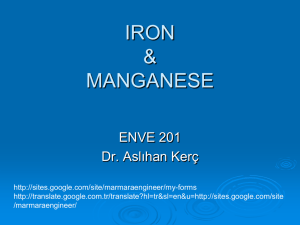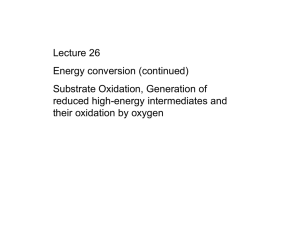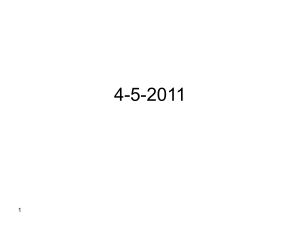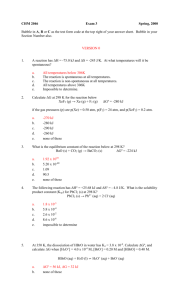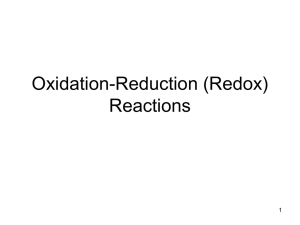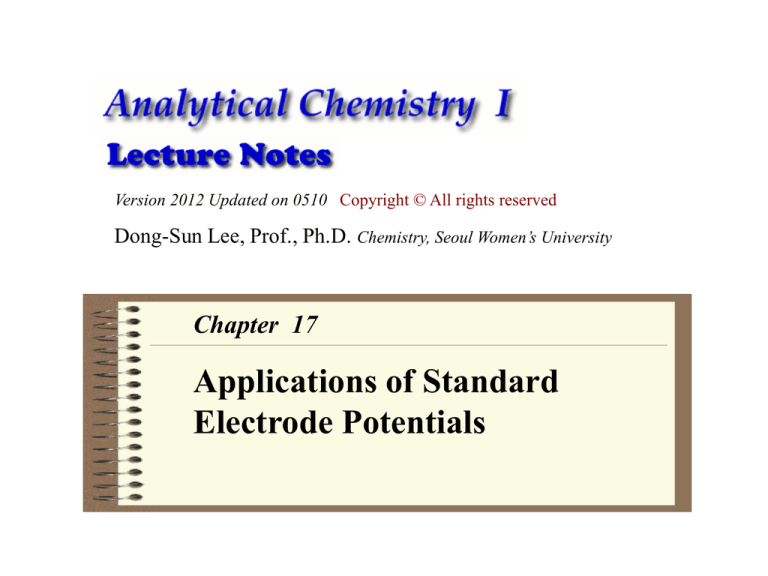
Version 2012 Updated on 0510 Copyright © All rights reserved
Dong-Sun Lee, Prof., Ph.D. Chemistry, Seoul Women’s University
Chapter 17
Applications of Standard
Electrode Potentials
Gustav Robert Kirchhoff(1824-1877)
was a German physicist who made
many important contributions to
physics and chemistry. In addition to
his work in spectroscopy, he is known
for Kirchhoff’s laws of current and
voltage in electrical circuits. These
laws can be summarized by the
following equations:
I = 0 and E = 0.
These equations state that the sum of
the currents into any circuit point
(node) is zero and the sum of the
potential differences around any circuit
loop is zero.
Calculating potentials of electrochemical cells
Ecell = Eright – Eleft
Ex.
Cu Cu2+(0.0200M)
Ag+(0.0200M) Ag
Cu (s) + 2Ag+ = Cu2+(aq) + 2Ag(s)
Ag+ + e = Ag(s)
Eo = + 0.799 V
Cu2+ + 2e = Cu(s)
Eo = + 0.337 V
2Ag+ + 2e = 2Ag(s) Eo = + 0.799 V
E = 0.799 – (0.05916/1) log (1/0.0200) = 0.6984 V
Cu2+ + 2e = Cu(s)
E = 0.337 – (0.05916/2) log (1/0.0200) = 0.2867V
Eo = + 0.337 V
Cu (s) + 2Ag+ = Cu2+(aq) + 2Ag(s)
Eocell = + 0.799 V – (+ 0.337 V)
= + 0.462 V
Ecell = Eright – Eleft = 0.6984 – 0.2864
= + 0.412 V
G = – nFE = – 2 ×96485 C × 0.412 V = 79,503 J (18.99 kcal)
EX
Calculate the potential of the following cell and indicate the reaction that would occur
spontaneously if the cell were short-circuited.
Pt U4+(0.200M), UO22+(0.0150M), H+(0.300M) Fe2+(0.0100M), Fe3+ (0.0250M) Pt
The two half-reactions are
Fe3+ + e_ ↔ Fe2+
UO22+ + 4H+ + 2e- ↔ U4+ + 2H2O
Eo = + 0.771V
Eo = + 0.334V
The electrode potential for the right-hand electrode is
Eright = 0.771 – 0.05916 log [Fe 2+]/[Fe 3+]
= 0.771 – 0.05916 log 0.0100/0.0250 = 0.771 – (– 0.0236) = 0.7946 V
The electrode potential for the left-hand electrode is
ELeft = 0.334 – (0.0592 / 2) log [U4+ ] / [UO22+][ H+]4
= 0.334 – (0.0592 / 2) log 0.200 / (0.0150) (0.0300) 4
= 0.334 – 0.2136 = 0.1204 V
And
E cell = E right – E left = 0.7946 – 0.2136 = 0.674V
The positive sign means that the spontaneous reaction is the oxidation of U4+ on the
left and the reduction of Fe 3+ on the right, or
U4+ +2 Fe 3+ + 2H2O ↔ UO22+ +Fe 2+ + 4H+
EX
Calculate the cell potential for
Ag AgCl (sat’d), HCl (0.0200M) H2(0.800atm ), Pt
Cell without liquid junction
Note that this cell does not require two compartments (nor a salt bridge) because
molecular H2 has little tendency to react directly with the low concentration of Ag+ in
the electrolyte solution. This is an example of a cell without liquid junction.
The two half- reactions and their corresponding standard electrode potentials are
2H+ + 2e - ↔ H2
AgCl(s) + e - ↔ Ag (s) + Cl–
EoH+/H2 = 0.000V
EoAgCl/Ag = 0.222V
The two electrode potentials are
Eright = 0.000 – (0.0592/2)log pH2 / [H+]2
= – (0.0592/2) log 0.800 / (0.0200) 3 = – 0.0977 V
Eleft = 0.222 – 0.0592log [Cl-] = 0.222 – 0.0592 log 0.0200 = 0.3226V
The cell potential is thus
E cell = E right – E left = -0.0977 – 0.3226 = – 0.420V
The negative sign indicates that the cell reaction as considered
2H+ + 2 Ag(s) ↔ H2 + 2AgCl(s)
is nonspontaneous. To get this reaction to occur, we would have to apply an external
voltage and construct an electrolytic cell.
Ex
Calculate the potential for the following cell using (a) concentration and (b) activities:
Zn ZnSO4(5.00 ×10–4 M), PbSO4 (sat’d) Pb
(a) [SO42–] = CZnSO4 = 5.00 ×10–4
PbSO4(s) + 2e Pb (s) + SO42–
Eo = – 0.350 V
Zn2+ + 2e Zn (s)
Eo = – 0.763 V
Eright = Eo – (0.05916 / 2) log [SO42–] = – 0.350 – (0.05916 / 2) log (5.00 ×10–4)
= – 0.252 V
Eleft = Eo – (0.05916 / 2) log (1 / [Zn2+]
= – 0.763 – (0.05916 / 2) log {1 / (5.00 ×10–4)} = – 0.860 V
Ecell = Eright – Eleft = – 0.252 – (– 0.860) = 0.608 V
(b) Ionic strength for 5.00 ×10–4 M ZnSO4 :
= (1/2) {(5.00 ×10–4) ×(+2)2 + (5.00 ×10–4) ×(– 2)2 } = 2.00 ×10–3
Debye-Huckel Eq. :
– log = (0.51 Z2 ) / ( 1+ 3.3 )
SO42– = 0.4 nm , Zn2+ = 0.4 nm
SO42– = 0.820,
Zn2+ = 0.825
Activity = [C]
Eright = Eo – (0.05916 / 2) log { SO42– [SO42–] }
= – 0.350 – (0.05916 / 2) log (0.820 × 5.00 ×10–4) = – 0.250 V
Eleft = Eo – (0.05916 / 2) log {1 / ( Zn2+ [Zn2+])}
= – 0.763 – (0.05916 / 2) log {1 / (0.825 × 5.00 ×10–4)} = – 0.863 V
Ecell = Eright – Eleft = – 0.250 – (– 0.863) = 0.613 V
Redox systems in the respiratory chain, P=phosphate ion.
(From P.Karlson, Introduction to modern Biochemistry.)
Calculation Redox Equilibrium Constant
Cu
Cu2+(x M) Ag+(y M) Ag
Cu (s) + 2Ag+ = Cu2+(aq) + 2Ag(s)
Keq = [Cu2+] / [Ag+]2
2Ag+ + 2e = 2Ag(s) Eo = + 0.799 V
Cu2+ + 2e = Cu(s)
Eo = + 0.337 V
Ecell = Eright – Eleft = EAg – ECu = 0
or
Eright = Eleft = EAg = ECu
EoAg – (0.05916/2) log (1/[Ag+]2) = EoCu – (0.05916/2) log (1/[Cu2+])
EoAg – EoCu = (0.05916/2) log (1/[Ag+]2) – (0.05916/2) log (1/[Cu2+])
EoAg – EoCu = (0.05916/2) log (1/[Ag+]2) + (0.05916/2) log ([Cu2+]/1)
2 (EoAg – EoCu ) / 0.05916 = log ([Cu2+]/[Ag+]2 ) = log Keq
ln Keq = –Go/RT= – nFEocell / RT
ln Keq = – nEocell / 0.05916 = – n (Eoright – Eoleft ) / 0.05916
<At 25oC >
Titration curve : potentiometric titration of Fe2+ with Ce4+.
Titration reaction: Ce4+ + Fe2+ Ce3+ + Fe3+
Cell:
HgHg2Cl2Cl– || Ce4+ , Ce3+ , Fe3+, Fe2+ | Pt
Reaction at the SCE reference electrode:
2Hg(l) + 2 Cl– Hg2Cl2(s) + 2 e
Eo = 0.241V
Reaction at the Pt indicator electrode:
Fe3+ + e Fe2+
Eo = 0.767V (in 1M HClO4 )
Ce4+ + e Ce3+
Eo = 1.70V (in 1M HClO4 )
Cell reaction: 2Fe3+ + 2Hg(l) + 2 Cl– 2 Fe2+ + Hg2Cl2(s)
2Ce4+ + 2Hg(l) + 2 Cl– 2 Ce3+ + Hg2Cl2(s)
ECe = EFe = Esolution
Ecell = Ecathode – Eanode = Esolution – ESCE
Eocell = (0.767)– (0.241) = 0.526 V
The equilibium constant for this titration reaction
K = 10 nEo/0.05916
log K = n
Eocell
K = 1.7 1017
/ 0.05916 = (1) (0.526) / (0.05916) =
Apparatus for potentiometric
titration of Fe2+ with Ce4+.
Initial Fe2+
½Ve
Ve
[Ce4+]
[Ce4+] = [Ce3+]
Theoretical titration curve
for titration of 100ml of
0.050M Fe2+ with 0.100M
Ce4+ in 1M HClO4.
[Fe2+] = [Fe3+]
[Ce3+] = [Fe3+]
Region
Major constituents
Comment
Before the titration begins
Fe2+
No calculation possible
Before the equivalence point
Fe2+ , Fe3+, Ce3+
Use the Nernst equation
for the analyte half reaction
At the equivalence point
Fe3+, Ce3+
Use e.p equation
After the equivalence point
Fe3+, Ce3+, Ce4+
Use the Nernst equation for
the titrant half reaction
1) Before the equivalence point
(amount Fe2+ remaining) = (amount Fe2+ initial) – (amount Ce4+ added amount Fe2+ used)
(amount Fe3+ produced) = (amount Fe2+ used)
[Fe2+] = amount Fe2+ (mmol) / vol(ml),
[Fe3+] = amount Fe3+ (mmol) / vol(ml)
Ecell = Ecathode – Eanode = Esolution – ESCE
= (0.767 – 0.05916 log{[Fe2+]/[Fe3+]}) – (0.241)
= 0.526 – 0.05916 log{[Fe2+]/[Fe3+]}
When V = (1/2) Ve,
[Fe2+] = [Fe3+],
Ecell = 0.526 .
2) At the equivalence point
[Ce3+] = [Fe3+]
[Ce4+] = [Fe2+]
Eeq = EoCe4+ – 0.05916 log[Ce3+]/ [Ce4+]
Eeq = EoFe3+ – 0.05916 log[Fe2+]/ [Fe3+]
2Eeq = EoCe4+ + EoFe3+– 0.05916 log[Ce3+]/ [Ce4+] – 0.05916 log[Fe2+]/ [Fe3+]
= EoCe4+ + EoFe3+– 0.05916 log[Ce3+] [Fe2+] / [Ce4+] [Fe3+]
= EoCe4+ + EoFe3+
= 1.70 + 0.767
= 2.467
Eeq = (EoCe4+ + EoFe3+ ) / 2 = 1.23 V
E(cell) = Eright – Ecalomel = 1.23 – 0.241 = 0.99V
3) After the equivalence point
[Fe2+] = 0
E(cell) = E+ – Ecalomel
= ( 1.70 – 0.05916 log [Ce3+]/[Ce4+]) – 0.241
amount Ce4+ remaining = amount Ce4+ added – amount Ce4+ used
= amount Ce4+ added – (amount Fe2+ initial × reacting ratio )
Titration curves for 0.1000M Ce4+ titration , Curve A: Titration of 50.00mL of
0.05000 M Fe2+. Curve B: Titration of 50.00 ml of 0.02500 M U4+.
General approach to redox titration
( titration with an oxidizing agent)
T
+
titrant
A
T– + A+
analyte
Mass balance
[T– ] + [T] = Ttotal
[T– ] + (1/ ) [T– ] = Ttotal
T + e
T–
[T– ] = ( Ttotal) / (1+ )
E = EoT – 0.05916 log [T– ] / [T]
[T– ] / [T] = 10 ( EoT – E) / 0.05916
[A+ ] = Atotal / (1+ )
[T– ] = [T]
[T– ] = [A+ ] 1:1 mole ratio
A+
+ e
A
( Ttotal) / (1+ ) = Atotal / (1+ )
E = EoA – 0.05916 log [A ] / [A+ ]
Fraction of titration
[A ] / [A+ ] = 10 ( EoA – E) / 0.05916
= Ttotal / Atotal
[A ] = [A+ ]
= (1+) / { ( 1+ )}
( = 1 at eq point)
Titration of a mixture
The titration of two species will exhibit two breaks if the standard potentials of the
redox couples are sufficiently different.
Example :
Titration reactions
First : IO3– + 2Sn2+ + 2Cl– + 6H+ ICl2– + 2Sn4+ + 3H2O
Second : IO3– + 2Tl+ + 2Cl– + 6H+ ICl2– + 2Tl3+ + 3H2O
Half reactions
IO3– + 2Cl– + 6H+ + 4e ICl2– + 3H2O
Eo = 1.24 V
= [ICl2– ] /[IO3– ] = 10 [4(1.24 – E) / 0.05916] – 2 pCl – 6 pH
Sn4+ + 2e Sn2+
Eo = 0.139 V
1 = [Sn2+]/[Sn4+] = 10 2 (0.139 – E) / 0.05916
Tl3+ + 2e Tl+
2 = [Tl+]/[Tl3+] = 10 2 (0.77 – E) / 0.05916
Eo = 0.77 V
Theoretical curve for titration of 100 ml of
0.01M Tl+ with 0.01M IO3– in 1M HCl
Theoretical curves for 0.01M Tl+
plus 0.01M Sn2+ titrated with
0.01M IO3–. The initial volume of
analyte is 100ml and all solutions
contain 1M HCl.
plot for the Fe2+/Ce4+ system.
Totration curve calculated
using the inverse master
equation approach.
= Fe3+ /Ce3+
Factors affecting the shape of titration curves :
1) concentration
concentrated
E(V)
diluted
V(ml)
2) completeness of reaction
Higher Eo titrant
E(V)
Lower Eo titrant
V(ml)
Effect of titrant electrode potential on reaction completeness.
Redox indicator
In(oxidized) + ne In(reduced)
E = Eo – (0.05916 / n) log [In(reduced)] / [In(oxidized)]
[In(reduced)] = [In(oxidized)]
E = Eo ± (0.05916 / n)
[In(reduced)] / [In(oxidized)] (10/1)
[In(reduced)]
[In(reduced)] / [In(oxidized)] (1/10)
[In(oxidized)]
Indicator transition range
vs SCE
= transition range – E(calomel)
vs SHE
Color changes for general redox indicators depend only on the potential of the system.
The range of potentials over which a color change occurs (the transition potential) is
often pH dependent.
Iron complexes of 1,10-phenanthrolines (orthophenanthrolines)
Starch-Iodine complex
Starch solution(05~ 1%) is not redox indicator.
The active fraction of starch is amylose, a polymer of the sugar -D-glucose
( 1,4 bond).
The polymer exists as a coiled helix into which small molecules can fit.
In the presence of starch and I–, iodine molecules form long chains of I5– ions
that occupy the center of the amylose helix.
••••[I I I I I]– ••••[I I I I I]– ••••
Visible absorption by the I5– chain bound within the helix gives rise to the
characteristic starch-iodine color.
Structure of the repeating unit of the sugar
amylose.
Schematic structure of the starch-iodine
complex. The amylose chain forms a
helix around I6 unit.
View down the starch helix, showing
iodine, inside the helix.
Potentiometric end points for redox titrations:
reference electrode || analyte solution | Pt
Reference electrode : SCE
The end point can be determined from a plot of the measured potential as a
function of titrant volume.
E(vs SCE)
Titrant volume
Summary
Potential of electrochemical cells
Redox equilibrium constant
Redox titration curve
Redox indicator
Iodine starch indicator

